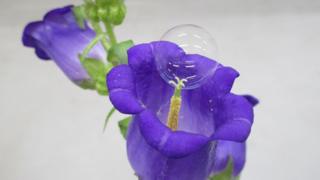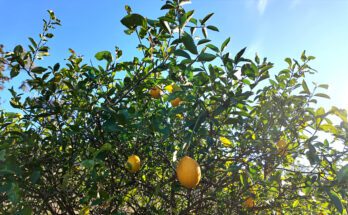
Image copyright
Eijiro Miyako
Japanese researchers have succeeded in fertilising pear trees using pollen carried on the thin film of a soap bubble.
They’ve been searching for alternative approaches to pollination, because of the decline in the number of bees worldwide.
When fired from a bubble gun, the delicate soapy spheres achieved a success rate of 95%.
The researchers are now testing drones that fire bubbles for pollination.
- A Bee C: Scientists translate honeybee queen duets
- Moths have ‘secret role’ as crucial pollinators
- Loss of British bees threatens food security
- City pollinators make beeline for violet blooms
With the decline in bee numbers over the past decade, researchers have been looking at different ways of achieving pollination – a key step in the production of many fruits and vegetables.
Dr Eijiro Miyako, from the Japan Advanced Institute of Science and Technology, had previously tested the ability of a drone to deliver pollen – but even though the drone was just two centimetres long, it kept damaging the flowers in the process.
One day, while watching his young son play in local park, Dr Miyako had a moment of inspiration.
Image copyright
Getty Images
“I was playing soap bubbles with my son at a park close to my home, when a soap bubble accidently hit my son’s face,” he told BBC News.
“There was no damage because soap bubbles are soft, light, and flexible.”
“But I got an inspiration because I thought the bubbles won’t damage the flowers and would be an ideal material for pollination.”
Dr Miyako commandeered the bubble solution, causing his son to start crying and necessitating the purchase of more bubbles.
In the lab, he was able to confirm, via optical microscopy, that soap bubbles could carry pollen.
Realising that most conventional soap would be too toxic for flowers, Dr Miyako developed what he terms “chemically functionalised” soap bubbles that could each carry up to 2,000 pollen grains.
Loading up their bubble guns, Dr Miyako and his colleagues tested the technique at a pear orchard.
In the absence of bees, some pollination work is now done by hand using a feather brush.
Image copyright
Getty Images
After shooting the bubbles onto the trees, young fruits started to form some 16 days later, at a volume equal to the hand pollination.
“The rates of both soap-bubble-mediated pollination and hand pollination were approximately 95%, and no significant differences were observed between them,” said Dr Miyako.
“In fact, the shape and size of young pear fruits after soap bubble pollination look the same as hand pollination. However our method has more potential advantages in terms of future automation and reduction of pollen grains.”
Soap bubbles, though, are not without their troubles. The technique creates a lot of waste and the wind and rain can ruin the efforts to pollinate.
Dr Miyako believes these restrictions can be overcome through the use of technology such as localisation and mapping, path planning and motion control.
Tests have already been carried out with an autonomous drone carrying a bubble gun.
The drone was able to hit targets from two metres with a success rate of 90%.
Dr Miyako is very optimistic about the potential for technology to succeed in pollination.
“Some might dismiss this as something of a fantasy, but the soap bubble is effective for pollination.”
“I was probably the only person on the planet to believe this when I started the ‘playful’ work. Maybe I still am now.”
The research has been published in the journal iScience.
Follow Matt on Twitter.
Read MoreFeedzy


